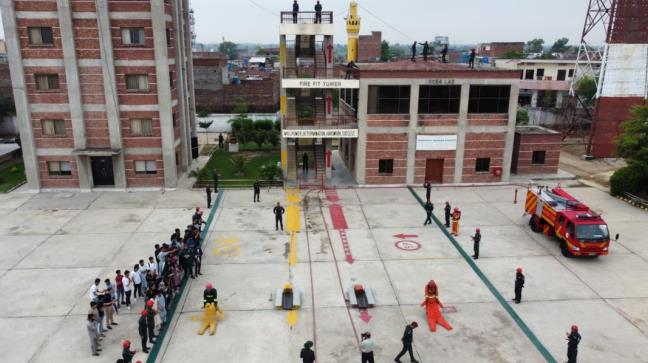Pakistan and China ought to join hands to face climate change: UMT Prof
LAHORE, Apr. 3 (Gwadar Pro) – “As you know, despite being responsible for less than 1 percent of global greenhouse gas emissions, Pakistan has been among the 10 countries most-affected from impacts of climate change in the past two decades,” noted Dr. Ahmad Ali Gul, an expert of China Biodiversity Conservation and Green Development Foundation (CBCGDF) Climate Change Working Group; Assistant Professor and Director, Center for Disaster Management, University of Management and Technology, during an interview with Gwadar Pro. “Our agriculture-based economy is sensitive to climate related shocks, and disasters can exacerbate the water security challenges.”

Rising number of people affected by floods in Pakistan [Photo/WRI]
Half a month ago, Dr. Gul participated in the Disaster Risk Management Symposium organized by the East Asian Biosphere Reserve Network (EABRN), making a speech on Pakistan’s lessons and opportunities in the context of global climate change. Soon after, an earthquake that jolts Afghanistan and Pakistan caused casualties and losses in both countries.
This may not be a coincidence. In reality, growing scientific evidence shows that climate change can increase the risk of such tremors. As melting glaciers change the distribution of weight across the Earth's crust, the resulting "glacial isostatic adjustment" drives changes in plate tectonics that could lead to more earthquakes. And besides earthquakes, other climate disasters are also threatening Pakistan’s fragile ecological balance, among which the 2022 flood sounded the alarm for the whole country and even the world.
“According to the official post disaster needs assessment (PDNA) 2022, the damages and losses were USD 14.9 billion and USD 15.3 billion respectively, with roughly 33 million people affected, of which 8 million were displaced. Preliminary estimates suggest that, as a direct consequence of these floods, the national poverty rate could jump to 4.0 percent, pushing up to 9 million people into poverty,” Dr. Gul emphasized, explicitly. Even worse, Pakistan is one of the most water-stressed countries in the world. Only 36 percent of Pakistanis have access to safely managed drinking water, down from 38 percent in 2004.

2022 floods cause untold damage in Pakistan [Photo/ Ahmad Ali Gul]
“Fundamentally, Pakistan’s vulnerability to climate change is deeply linked with its socio-economic challenges and governance.” As per Dr Gul, besides the climate itself, other factors perpetuate a state of vulnerability and turn a hazard into a disaster.
Domestic institutions at all levels still follow a response-centric approach to disaster management, and disaster risk management (DRM) is not integrated with the planning and development process, namely, development initiatives often end up increasing risk rather than decreasing it - causing maladaptation. Dr Gul told the reporter that much of the critical infrastructures, including hospitals, major roads and power, was badly affected during 2022 floods because it was located in high-risk areas without appropriate safeguard measures. Moreover, this situation is exacerbated by limited hydrometeorological measurement and research.
So how can Pakistan get rid of the passive status quo to deal with the increasingly severe climate challenge proactively and constructively? “The communities which faced floods this year were facing drought few years ago,” Dr Gul mentioned, “small storages, dams, reservoirs and ecosystems-based solutions are needed to build climate resilience for these communities. Above all, awareness needs to happen at a community level. The easiest way is to facilitate and empower community-based-organizations (CBOs), and raise awareness at the school level.”

An on-going training exercise at the 1122 Emergency Services Academy, Lahore [Photo/ Ahmad Ali Gul]
Being both China and Pakistan own complex terrain, diverse climates and high population density, broad prospects of cooperation could be expected in disaster risk management. “We have some collaboration related to satellite monitoring technologies, but there is surely more potential.” According to Dr Gul, advanced hydrological measurement systems, precipitation radars and flood protection infrastructures are some areas we really need technological support and investment. “Making cities more sustainable through adoption of nature-based solutions and green infrastructure in an urban setting, which are something that we should learn from China.”
“Another thing that affects major parts of Pakistan is smog. We have some of the most polluted cities in the world. Thus, we can really learn from China’s success story in improving air quality over a considerably short period of time.”
When talking future planning, Dr Gul also made a special mention of the role that China-Pakistan Economic Corridor has played. “Poverty is one of the biggest factors contributing to climate vulnerability. CPEC is bringing very significant socio-economic benefits to Pakistan, which will certainly help improve the people’s resilience and ability to respond to various climate disasters. Second, transportation infrastructure under CPEC can significantly improve the connectivity of domestic transportation network. In particular, many remote areas that were once inaccessible now have safe and reliable road connectivity, which can greatly improve the disaster response time and disaster relief logistics.”




